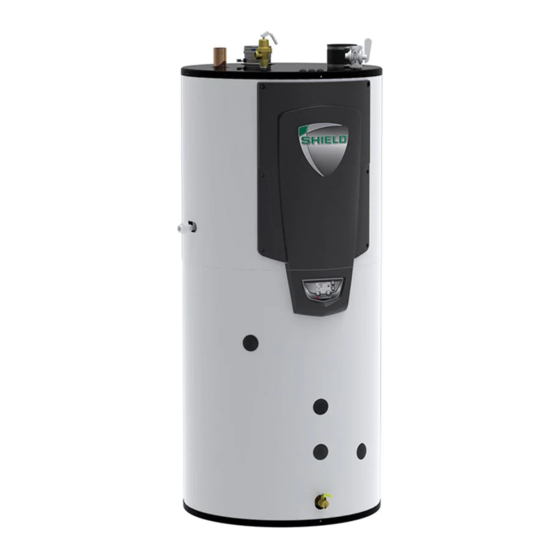Table of Contents
Advertisement
WARNING:
If the information in these instructions
is not followed exactly, a fire or explosion may result
causing property damage, personal injury or death.
-- Do not store or use gasoline or other flammable vapors and
liquids in the vicinity of this or any other appliance.
-- WHAT TO DO IF YOU SMELL GAS
• Do not try to light any appliance.
• Do not touch any electrical switch; do not use any phone
in your building.
• Immediately call your gas supplier from a near by phone.
Follow the gas supplier's instructions.
• If you cannot reach your gas supplier, call the fire
department.
-- Installation and service must be performed by a qualified
installer, service agency, or the gas supplier.
Installation & Service
Manual
Models: SNR126-065, SNR151-100,
SNR201-100, SNA151-100, SNA201-100,
SNA286-125, SNA401-125, AND SNA501-125
This manual must only be used by
WARNING
a qualified heating installer / service
technician.
this manual before installing. Perform
steps in the order given. Failure to
comply could result in severe personal
injury, death, or substantial property
damage.
Save this manual for future reference.
SHW-I-S Rev B
Read all instructions in
Advertisement
Table of Contents
Troubleshooting

Summarization of Contents
Please Read Before Proceeding
Hazard Definitions and Safety Precautions
Explains hazard terms, gas leak actions, and general operation safety.
Product Ratings and Specifications
High Altitude Performance
Details altitude adjustments and performance derating.
Water Heater Location and Installation Requirements
General Location and Clearance Guidelines
Covers overall placement, closets, alcoves, and clearances.
Combustion Air and Venting Location
Requirements for air intake and vent termination placement.
Existing Vent System Integration
Procedures for using existing vent systems.
General Venting Procedures
Direct Venting Options
Sidewall and vertical venting configurations.
Vent and Air Piping Installation
Steps for installing vent and combustion air piping.
Venting Materials and Requirements
Approved materials (PVC, Polypropylene, SS) and Canadian standards.
Air Intake and Contamination
Materials for air intake and hazards of contamination.
Sidewall Direct Venting
Sidewall Termination Guidelines
Rules for terminating vent and air pipes through sidewalls.
Wall Penetration Preparation
Steps for creating openings in walls for vent/air.
Concentric Sidewall Termination
Installation of optional concentric kits.
Vertical Direct Venting
Vertical Termination Guidelines
Rules for terminating vent and air pipes through roofs.
Roof Penetration Preparation
Steps for creating openings in roofs for vent/air.
Concentric Vertical Termination
Installation of optional concentric kits.
System Piping Installation
Water Piping Methods and General Information
Covers piping types, general installation steps, and scald hazards.
Water Chemistry and Components
Importance of water quality and required piping parts.
Gas Connections and Supply
Connecting Gas Supply Piping
Steps for connecting the gas line.
Natural and Propane Gas Requirements
Pipe sizing and pressure needs for both gas types.
Inlet Gas Supply and Valve Checks
Verifying supply and checking gas valve.
Field Wiring and Connections
Low Voltage Wiring and Control Interfaces
Covers low voltage connections, enable switch, louver controls, and status contacts.
Condensate Disposal
Condensate Drain Installation and Maintenance
Proper installation and care of the condensate drain.
Start-Up Procedures
Pre-Start Checks and Gas Leak Detection
Critical steps before initial operation.
Condensate System Prep and Final Checks
Ensuring condensate system is ready and final overall checks.
Initial Operation and Combustion Analysis
Steps for starting the unit and checking combustion.
Operating Information and Controls
Core Operation and Temperature Control
Covers general operation, temp control, modulation, night setback, and freeze protection.
Protection Features and System Outputs
Details safety features, runtime/alarm contacts, and error logging.
Maintenance and Service Schedules
Technician and Owner Responsibilities
Outlines annual startup and owner tasks.
System Component Inspection and Cleaning
Covers area, interior, condensate trap, piping, flue, and water systems.
Component Specific Maintenance
Covers expansion tank, relief valve, electrodes, wiring, and control settings.
Post-Maintenance Startup Checks
Performing initial checks after maintenance.
Burner and Flame Checks
Inspecting burner flame, signal, and reviewing with owner.
Heat Exchanger and Circulator Maintenance
Cleaning heat exchanger, checking circulators and anode rods.
Troubleshooting and Diagnostics
Initial Checks and Fuse Verification
Essential steps before troubleshooting and checking fuses.
System Component Diagnostics
Troubleshooting charts for no display, noisy system, and sensor checks.
Fault Message Interpretation and Resolution
Diagnosing and resolving error codes displayed on the interface.
Combustion and Gas Valve Adjustments
Procedures for analyzing combustion and adjusting the gas valve.
System Diagrams
Electrical Schematics: Ladder and Wiring
Provides ladder and wiring diagrams for electrical systems.





Need help?
Do you have a question about the SNA501-125 and is the answer not in the manual?
Questions and answers